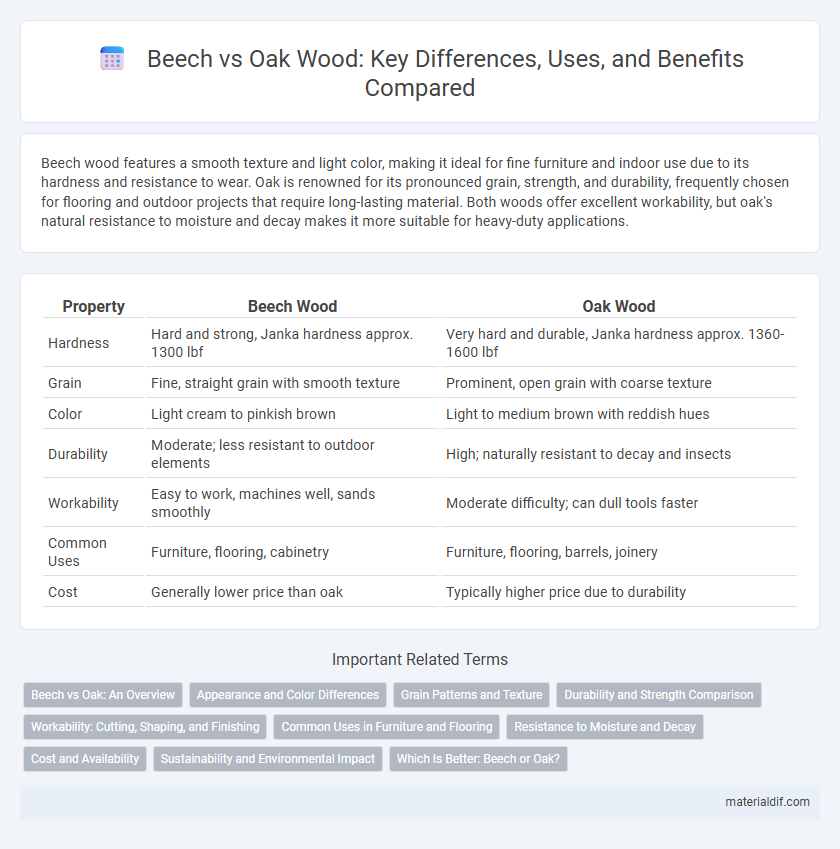Beech wood features a smooth texture and light color, making it ideal for fine furniture and indoor use due to its hardness and resistance to wear. Oak is renowned for its pronounced grain, strength, and durability, frequently chosen for flooring and outdoor projects that require long-lasting material. Both woods offer excellent workability, but oak's natural resistance to moisture and decay makes it more suitable for heavy-duty applications.
Table of Comparison
| Property | Beech Wood | Oak Wood |
|---|---|---|
| Hardness | Hard and strong, Janka hardness approx. 1300 lbf | Very hard and durable, Janka hardness approx. 1360-1600 lbf |
| Grain | Fine, straight grain with smooth texture | Prominent, open grain with coarse texture |
| Color | Light cream to pinkish brown | Light to medium brown with reddish hues |
| Durability | Moderate; less resistant to outdoor elements | High; naturally resistant to decay and insects |
| Workability | Easy to work, machines well, sands smoothly | Moderate difficulty; can dull tools faster |
| Common Uses | Furniture, flooring, cabinetry | Furniture, flooring, barrels, joinery |
| Cost | Generally lower price than oak | Typically higher price due to durability |
Beech vs Oak: An Overview
Beech wood features a fine, tight grain with a light color, making it ideal for furniture and interior finishes, while oak is denser, showcasing prominent grain patterns and higher durability. Oak's natural resistance to moisture and decay surpasses beech, which can be prone to swelling in damp conditions. Both hardwoods offer excellent strength, but oak is preferred for heavy-use applications, whereas beech excels in smooth, detailed craftsmanship.
Appearance and Color Differences
Beech wood typically features a pale cream to light reddish-brown color with a fine, even grain, creating a smooth and uniform appearance ideal for modern furniture. Oak wood displays a more pronounced grain pattern with distinctive rays and knots, ranging from light tan to deep reddish-brown hues, giving a rustic and textured look. The contrasting grain intricacy and natural color variations between beech and oak make each wood type uniquely suited for different design aesthetics.
Grain Patterns and Texture
Beech wood features a fine, tight grain with a uniform texture that provides a smooth and consistent surface, ideal for precise woodworking and furniture making. Oak displays a prominent, open grain pattern with more pronounced rays and flecks, offering a rustic, textured appearance favored in flooring and cabinetry. The denser, coarser texture of oak contrasts with beech's softer, finer feel, influencing both aesthetic and tactile qualities in wood projects.
Durability and Strength Comparison
Beech wood offers moderate durability with a Janka hardness of about 1,300 lbf, making it suitable for indoor furniture but less resistant to decay compared to oak. Oak, particularly white oak, boasts superior durability and strength, with a Janka hardness around 1,360 lbf and excellent resistance to moisture and fungal attacks, ideal for both indoor and outdoor applications. The natural density and tight grain structure of oak contribute to its higher load-bearing capacity and longevity over beech in structural uses.
Workability: Cutting, Shaping, and Finishing
Beech wood offers excellent workability due to its fine, even grain, making cutting, shaping, and finishing smooth and precise. Oak, while harder and denser, requires sharper tools for cutting and shaping but provides a durable finish that highlights its prominent grain patterns. Both woods respond well to sanding and staining, with beech favoring intricate detailing and oak excelling in robust, long-lasting furniture.
Common Uses in Furniture and Flooring
Beech wood is frequently used in furniture manufacturing for its smooth texture and light color, making it ideal for chairs, tables, and cabinetry that require easy shaping and uniform finish. Oak wood is highly favored in flooring due to its exceptional durability, prominent grain patterns, and resistance to wear, providing long-lasting and visually appealing hardwood floors. Both woods serve well in furniture but oak's robustness often makes it the preferred choice for high-traffic flooring applications.
Resistance to Moisture and Decay
Beech wood exhibits moderate resistance to moisture but is more susceptible to decay compared to oak, which is naturally more durable and resistant to fungal attacks. Oak's dense grain structure and high tannin content enhance its resistance to rot and moisture damage, making it preferable for outdoor applications and environments with high humidity. Choosing oak over beech improves longevity and structural integrity in moisture-prone conditions.
Cost and Availability
Beech wood generally costs less than oak due to its wider availability and faster growth rate, making it a more economical choice for furniture and flooring projects. Oak, known for its durability and prominent grain patterns, tends to be more expensive and less readily available, especially in its premium grades. The higher cost of oak reflects its longer maturation time and higher demand in the market.
Sustainability and Environmental Impact
Beech wood is considered more sustainable than oak due to its faster growth rate and higher yield per hectare, reducing pressure on forests. Oak trees require longer maturation periods, leading to extended carbon sequestration but slower replenishment compared to beech. Both woods have carbon storage benefits, but beech's rapid renewability makes it preferable for eco-conscious forestry and timber industries.
Which Is Better: Beech or Oak?
Oak wood boasts superior durability and strength, making it ideal for heavy-use furniture and flooring, while beech offers a smoother texture and lighter color, preferred for cabinetry and interior detailing. Oak's higher natural resistance to moisture and decay enhances its longevity in outdoor or high-humidity environments compared to beech. Cost-wise, beech is generally more affordable and easier to work with, though oak's premium quality often justifies its higher price point in fine woodworking projects.
Beech vs Oak Infographic

 materialdif.com
materialdif.com